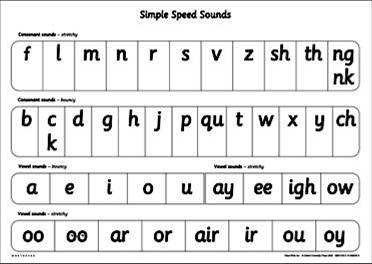
PHONICS – READ WRITE INC.
English is a complex code!
- All words are made up of sounds.
- In English there are 44 sounds.
How will I know how to pronounce the phonic sounds?
- You can practise saying the sounds by using the chart below
How will I know how to recognise the grapheme for each sound?
- A grapheme is a sound written down i.e the letter symbol.
- English has more than 150 graphemes.
- This chart shows the most usual graphemes for the 44 sounds.

Set 1 Sounds are taught in the following order:
m a s d t, i n p g o, c k u b, f e l h sh, r j v y w, th z ch qu x ng nk
With Read, Write Inc we are using pure sounds, (‘m’ not’ muh’, ’s’ not ‘suh’, etc) so that your child will be able to blend the sounds into words more easily.
| These first sounds should all be stretched slightly.Try to avoid saying uh after each one e.g. /mm/ not muh, /ss/ not suh, /ff/ not fuh. | |
| m | mmmmmmountain (keep lips pressed together hard |
| s | sssssnake (keep teeth together and hiss – unvoiced) |
| n | nnnnnnet (keep tongue behind teeth) |
| f | ffffflower (keep teeth on bottom lip and force air out sharply – unvoiced) |
| l | llllleg (keep pointed curled tongue behind teeth). |
| r | rrrrrrobot (say rrr as if you are growling) |
| v | vvvvvvulture (keep teeth on bottom lip and force air out gently) |
| z | zzzzzzig zzzzzag (keep teeth together and make a buzzing sound) |
| th | thhhhank you ( stick out tongue and breathe out sharply) |
| sh | shhhh (make a shhh noise as though you are telling somebody to be quiet!) |
| ng | ng – thinnnnngg on a strinnnngg (curl your tongue at the back of your throat) |
| nk | I think I stink (make a piggy oink noise without the oi! nk nk nk) |
| These next sounds cannot be stretched.Make the sound as short as possible avoiding uh at the end of the sound: | |
| t | tick tongue behind the teeth – unvoiced |
| p | make distinctive p with lips – unvoiced |
| k | make sharp click at back of throat |
| c | as above |
| h | say h as you breathe sharply out – unvoiced) |
| ch | make a short sneezing sound |
| x | say a sharp c and add s – unvoiced |
| You will find it harder to avoid saying uh at the end of these sounds. | |
| d | tap tongue behind the teeth |
| g | make soft sound in throat |
| b | make a short, strong b with lips |
| j | push lips forward |
| y | keep edges of tongue against teeth |
| w | keep lips tightly pursed |
| qu | keep lips pursed as you say cw – unvoiced |
| The short vowels should be kept short and sharp: | |
| a | a-a-a (open mouth wide as if to take a bite of an apple |
| e | e-e-e (release mouth slightly from a position). |
| i | i-i-i (make a sharp sound at the back of the throat – smile). |
| o | o–o-o (push out lips, make the mouth into o shape). |
| u | u-u-u (make a sound in the throat). |
Set 2 Sounds are taught in the following order:
ay, ee, igh, ow, oo, ar, or, air.ir, ou, oy, ire
When the children are very confident with all of Set 1 and Set 2 sounds then they are taught Set 3 Sounds.
The long vowel sounds are all stretchy sounds.
| Long vowel sound | Set 2 Sounds | Set 3 Sounds | |
| Ay | ay: may I play | a-e: make a cake | ai: snail in the rain |
| Ee | ee: what can you see | ea: cup of tea | e: he me we she be |
| igh | igh: fly high | i-e: nice smile | |
| Ow | ow: blow the snow | o-e: phone home | oa: goat in a boat |
| Oo | oo: poo at the zoo | u-e: huge brute | ew: chew the stew |
| Oo | oo: look at a book | ||
| Ar | ar: start the car | ||
| Or | or: shut the door | aw: yawn at dawn | |
| air | air: that’s not fair | are: share and care | |
| Ir | ir: whirl and twirl | ur: nurse for a purse | er: a better |
| Ou | ou: shout it out | ow: brown cow | |
| Oy | oy: toy for a boy | oi: spoil the boy | |
| ire | ire: fire fire! | ||
| ear | ear: hear with your ear | ||
| ure | ure: sure it’s pure? |
So how can you help your child?
By knowing the 44 pure sounds.

By using the Speed Sound cards with your child.

By knowing how to blend using Fred Talk for reading.
By knowing how to do Fred Fingers for spelling.

By having fun with Fred Talk at home!
“What a tidy r-oo-m!”
“Where’s your c-oa-t?”
“Time for b-e-d!”
By reading to your child lots of lovely stories and asking lots of questions.

By taking time to talk!
By praising your child for using new words or interesting images.
By visiting the parent page for Read Write Inc on Oxford University Press’ website.
